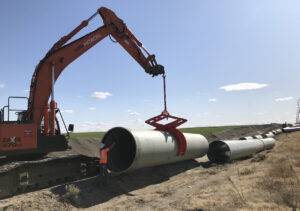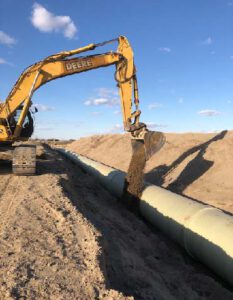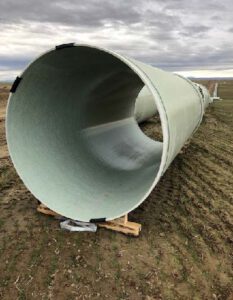Thompson Pipe Group is a national pipe manufacturer that works on municipal and irrigation pipe projects across North America. It manufactures steel, fiberglass-reinforced plastic (FRP), and concrete pipe as well as joints and fittings. Thompson also manufactures products for trenchless pipe installation.
In this interview, Thompson Pipe Group Trenchless and Pacific Northwest Manager Carl Pitzer tells Irrigation Leader about the characteristics and uses of each type of pipe his company builds and about trends in the pipe industry.
Irrigation Leader: Please tell us about your background and how you came to be in your current position.
Carl Pitzer: I graduated from Oregon State University’s construction engineering management program in 2012. After graduation, I went to work for Kiewit Construction and worked on the structures on the 520 floating bridge project in Seattle, Washington, for a little under 4 years. As that project came to an end, a friend I’d worked with on the bridge accepted a position with Thompson Pipe Group. The company said it was looking for somebody in the Northwest with my sort of background, so in 2015, I accepted the job.
Irrigation Leader: Please tell us about Thompson Pipe Group and its history.
Carl Pitzer: Thompson Pipe Group was founded by Ken Thompson in 1972 as Thompson Brothers Utility Construction and worked as a large utility contractor, installing large-diameter concrete pipe in Southern California. It developed a way to cast pipe in place in the trench and eventually started precasting pipe. The company saw a need for quality reinforced concrete pipe, and in 1987, it broke

ground on its first reinforced concrete pipe manufacturing facility in Rialto, California. Since then, the company has grown quickly. In 2008, we acquired the Flowtite FRP pipe manufacturing facility, and in 2017, we acquired the U.S. Pipe and Forterra pressure assets. With that acquisition, we gained additional manufacturing facilities in Florida, Illinois, Tennessee, and Texas. Having grown from a contractor to a pipe manufacturing company, the company changed its name to Thompson Pipe Group. Despite its growth, the company is still a private, family-owned business.
With our expanded footprint and manufacturing capabilities, we manufacture and supply different types of pipe, including FRP; C200 steel pipe; reinforced concrete pipe; and reinforced concrete pressure pipes, mainly prestressed concrete cylinder pipe and bar-wrapped pipe. We also manufacture a number of products for trenchless pipe installation, including products for microtunneling, pipejacking, and sliplining.
Irrigation Leader: How does trenchless installation work?
Carl Pitzer: For microtunneling and jacking operations, a pipe is typically advanced behind a tunnel boring machine, which is pushed through the ground. The pipe is pushed forward by a ram, and the pipe, in turn, pushes the tunnel boring machine forward. The rams are retracted, another pipe segment is placed behind the segment that has just been pushed, and the cycle is repeated. There’s nothing micro about microtunneling or pipe jacking: We recently supplied 132‑inch pipe for a project in California. The pipe diameter is limited only by the size of the machine, and I believe the largest microtunneling machine in the world is a 4.8‑meter machine.
Irrigation Leader: Who are Thompson’s customers and clients?
Carl Pitzer: We produce pipe for every part of the water transmission industry. We manufacture and supply pipes for irrigation, raw water transmission, power plants, hydropower production, potable water, sewer conveyance, and even to use as casing pipes to hold other pipes. We sell directly to owners, contractors, and developers.
Irrigation Leader: Please tell us about some of your recent projects.
Carl Pitzer: A lot of our recent projects in the irrigation market have involved Flowtite FRP pipe. The projects generally involve pumping water to expanded cropland within irrigation districts. We have also been involved in projects to enclose canals to reduce seepage and evaporation losses.
One of our recent projects was with the Port of Morrow in Boardman, Oregon. It involved about 16 miles of 30‑inch, 200‑pound-per-square-inch (psi) pipe. That pipe will be used primarily for the processing of potatoes and other vegetables that goes on in the Port of Morrow. Instead of treating the water that is used in that process and releasing it back into the Columbia River, it’s more sustainable to pump it to a holding pond 16 miles away, where irrigators can reuse it for their crops.
Another ongoing project is the Columbia Improvement District project. We are supplying roughly 8½ miles of 75‑and 72‑inch diameter, 200 psi pressure FRP pipe to run parallel to an existing line.

Irrigation Leader: Are there differences in the kind of pipe that irrigation clients want versus what municipal clients want?
Carl Pitzer: I don’t think so. Each pipe has its role and each project has a different set of requirements. With the Columbia Improvement District project, the fiberglass pipe that they’re using is unrestrained, meaning that it’s a push-on joint that doesn’t need to be welded, which means it can be installed much more quickly. Where the pipeline changes direction, we manufacture and supply steel fittings that are welded to handle the thrust instead of pouring thrust blocks.
Irrigation Leader: How do you design your products to be resilient to natural disasters such as earthquakes?
Carl Pitzer: For earthquakes, it’s a question of understanding your ground conditions and how the earthquake will travel through the ground. You need to check that your joints can handle the expected rotation and displacement.
If the ground is stable and you’re only concerned about it shaking, meaning that there’s no liquefaction or permanent ground displacement, then segmented joints can be used effectively. Each joint will dissipate the energy of an earthquake, rather than storing it. The opposite would happen in a long continuous pipe, which could potentially store the energy. Fiberglass pipes that were installed for the Los Angeles Department of Water and Power recently went through two earthquakes without any incident.
Irrigation Leader: What challenges and trends do you see in the concrete and fiberglass pipeline industry?
Carl Pitzer: One of the biggest challenges that we have had is educating folks about using FRP pipe for pressure applications. It has been accepted in the United States as a gravity sewer product for a long time because it is noncorrosive, but educating owners and engineers about its potential as a pressure product has taken quite a while. While it is considered new in the United States, fiberglass pipe has been installed in pressure projects around the world since the late 1960s. Roughly half of the world FRP market is for pressure projects, including irrigation and hydropower. Countries in South America make extensive use of FRP for irrigation and hydropower. Large projects in Turkey use it transport raw water and irrigation water hundreds of miles. New Zealand and Australia also use FRP for a lot of irrigation pipelines.
One trend in North America is that reinforced concrete pipe is becoming a preferred product for tunneling operations. As projects get longer and more complex, concrete offers what other materials can’t, including the ability to tunnel curves and to go for longer distances.

Irrigation Leader: Why are American clients reluctant to use FRP? Is it just unfamiliarity with the product?
Carl Pitzer: Yes, mainly it is unfamiliarity. A lot of times, clients will ask us to show them an example of the product in use, but if we point to a project in another country or state, they want something closer. Most people don’t want to be the first to try something in their region. I’ve noticed that irrigation clients, on the other hand, are open to new ideas and technologies as long as the benefits are there. They don’t mind if the product has only been used far away; they’re open to the product if it has merit.
Irrigation Leader: Why do you think that is?
Carl Pitzer: Irrigation clients have a get-it-done mentality. I do not see a lot of bureaucracy with them. They are looking for the best value. Some of the districts are privately owned and funded, and the owners are the ones making the decisions about these kinds of things. They take everyone’s critical thinking into account and trust their engineers.
Carl Pitzer is the trenchless manager at Thompson Pipe Group and manages its Pacific Northwest Operations. He can be contacted at
cpitzer@thompsonpipegroup.com or (971) 227‑3920.
